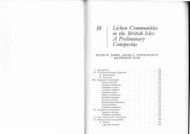You also want an ePaper? Increase the reach of your titles
YUMPU automatically turns print PDFs into web optimized ePapers that Google loves.
The causes are many, the sensitivity to air<br />
pollution plays an important role.<br />
For <strong>Baden</strong>-<strong>Württemberg</strong> (valid also for the<br />
immediate environs) after the frequency<br />
statements the statement in parentheses about the<br />
endangerment is in the form <strong>of</strong> the number from<br />
the Red List. They mean<br />
0: Extinct or missing<br />
1: In danger <strong>of</strong> extinction<br />
2: Strongly endangered<br />
3: Endangered<br />
R: Extremely rare<br />
Annotations <strong>of</strong> the categories (according to the<br />
definitions <strong>of</strong> the BfN/Institute for vegetation<br />
studies):<br />
1: Species which are so severely endangered that<br />
they face extinction, if the threatening causes<br />
continue. One <strong>of</strong> the following criteria must be<br />
fulfilled: (1) the species is so considerably<br />
regressed that they are rare; the remaining<br />
population is endangered; (2) they are now rare<br />
and because <strong>of</strong> continuing human influence<br />
extraordinarily strongly endangered.<br />
2: Species, which are extensively regressing or<br />
because <strong>of</strong> continuing or foreseeable human<br />
influence are strongly endangered. One <strong>of</strong> the<br />
following criteria must additionally be fulfilled:<br />
(1) the species has already disappeared in the<br />
greater part <strong>of</strong> the region; (2) it is very rare to<br />
rare; (3) it is still moderately frequent, but<br />
strongly endangered; (4) the diversity <strong>of</strong> their<br />
formerly colonized habitat is extensively<br />
restricted.<br />
3: Species, which are moderately regressing or<br />
because <strong>of</strong> continuing or foreseeable human<br />
influence are endangered. One <strong>of</strong> the following<br />
criteria must additionally be fulfilled: (1) the<br />
species is already very rare in the greater part <strong>of</strong><br />
the region; (2) it is rare to moderately frequent;<br />
(3) it is still frequent, but strongly endangered;<br />
(4) the diversity <strong>of</strong> the formerly colonized habitat<br />
is restricted.<br />
R: Extremely rare species at this time. They are<br />
not appreciably regressed or not noticeably<br />
endangered and they may on the basis <strong>of</strong> their<br />
scarcity be suddenly destroyed or essentially<br />
decimated due to unforeseen developments, e.g.<br />
by a combination <strong>of</strong> unexpected human intrusion<br />
or natural events like rock slides. A statement in<br />
italics means that the classification must be seen<br />
as relatively uncertain. An asterisk (*) after the<br />
Red List Rating means that the species in the<br />
environs around <strong>Baden</strong>-Württem-berg is clearly<br />
less endangered.<br />
In the case <strong>of</strong> species not occurring in<br />
<strong>Baden</strong>-<strong>Württemberg</strong> (as a rule after the statement<br />
<strong>of</strong> natural area) the following symbol was used:<br />
+: extinct, (+++): in danger <strong>of</strong> becoming extinct,<br />
(++): strongly endangered, (+): endangered, *:<br />
extremely rare. Species with especially<br />
remarkable value <strong>of</strong> resistance to (mostly acid)<br />
air pollution were designated as toxic tolerant.<br />
4.5 Statements <strong>of</strong> Plant Geography<br />
For the characterization <strong>of</strong> plant areas one uses<br />
certain geographical statements in which<br />
particularly the north to south extending<br />
(zonation), in addition to the west to east<br />
extending (continents) and the elevational<br />
distribution. The clarification <strong>of</strong> the concepts<br />
used here comes from the following combination.<br />
The definition <strong>of</strong> the individual geographic<br />
regions is from the diagram (refer to MEUSEL,<br />
JAEGER & WEINERT).<br />
4.5.1 Floral Regions and Floral Elements<br />
(Europe)<br />
arct = arctic: Tundra region north <strong>of</strong> the polar<br />
tree line. Many <strong>of</strong> the species occurring in this<br />
region are also to be found in the alpine zone <strong>of</strong><br />
the vegetation zones lying further south<br />
(arct-alp).<br />
bor = boreal: Region <strong>of</strong> the boreal pine belt.<br />
The species occurring in this region are further<br />
found for the most part in the montane and high<br />
montane zones <strong>of</strong> the temperate (central<br />
European) zone.<br />
s’bor = southern boreal: Southern region <strong>of</strong> the<br />
boreal zone (narrowing toward the east).<br />
mieur = middle European (or temperate):<br />
Temperate zone, region <strong>of</strong> green summer<br />
deciduous forests (in part intermixed with pine<br />
forests).<br />
s’mieur = southern middle European: Southern<br />
region <strong>of</strong> the temperate zone.<br />
smed = sub-Mediterranean: Region <strong>of</strong> green<br />
summer dry forests (above all oak forests) and<br />
steppes, northern Mediterranean region.<br />
med = Mediterranean: Non deciduous evergreen<br />
and pine forests, steppes and semi-desert<br />
southern Mediterranean.<br />
atl = Atlantic: Deciduous forested region near<br />
the Atlantic (in central Europe eastern to NW<br />
Germany, central and upper Rhine).<br />
subatl = Sub Atlantic: Region <strong>of</strong> the deciduous<br />
forest <strong>of</strong> west and central Europe. Species in the<br />
24





